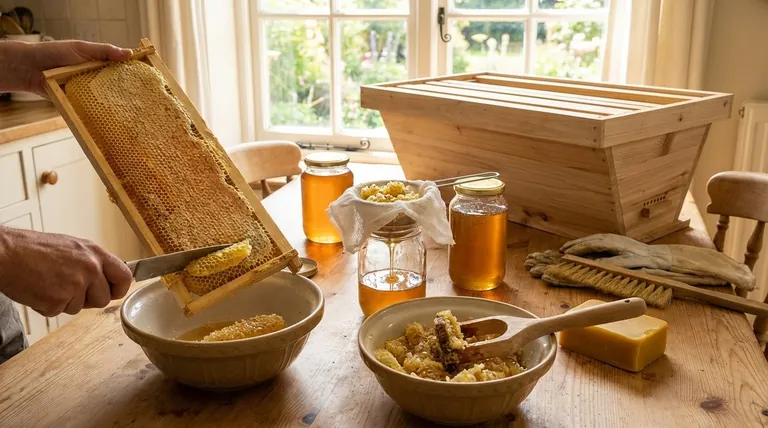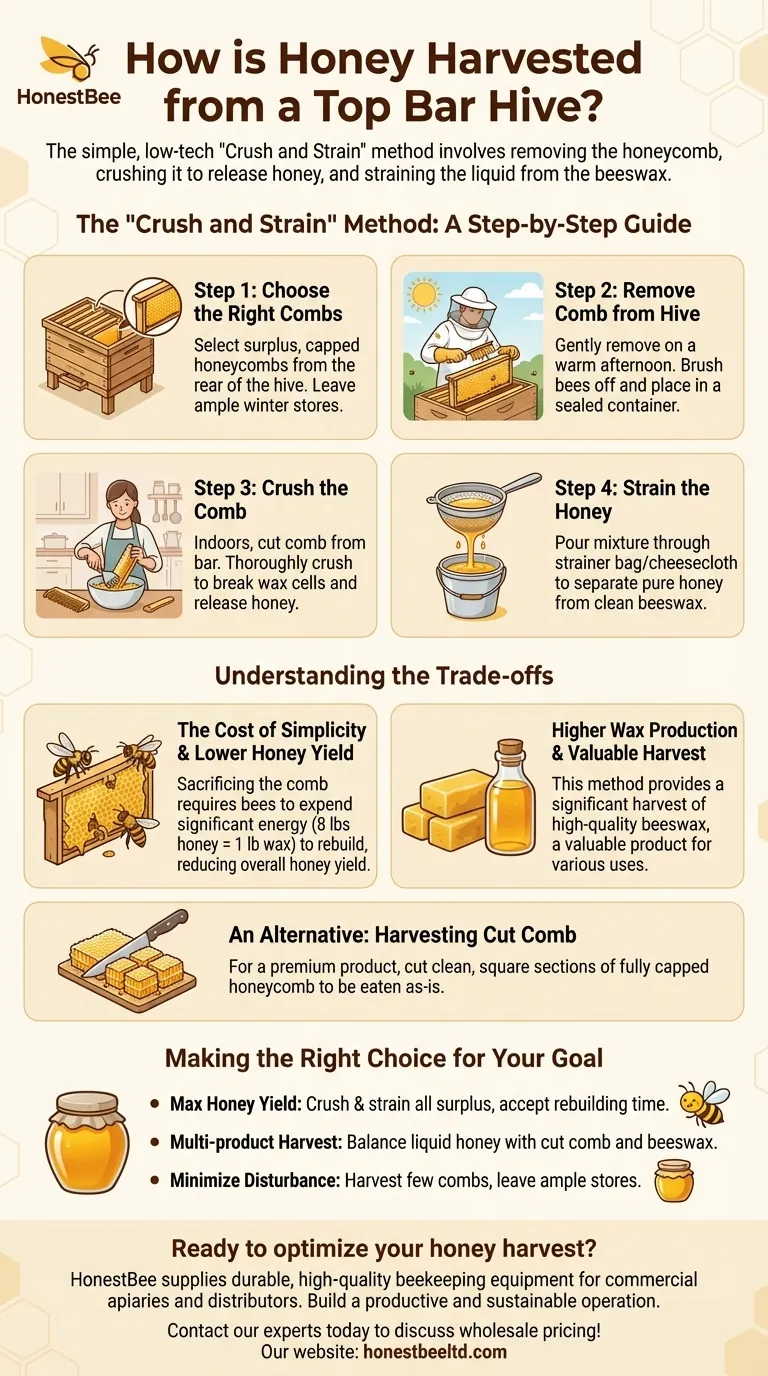To harvest honey from a top bar hive, you use a simple, low-tech method known as "crush and strain." This process involves removing the entire honeycomb from the hive, cutting it from its top bar, crushing the comb to release the honey, and then straining the liquid honey from the solid beeswax. It requires minimal specialized equipment and can be done with basic kitchen tools.
The top bar harvesting method is intentionally simple, avoiding expensive equipment. However, this simplicity comes with a critical trade-off: the entire comb is sacrificed, which reduces honey yield compared to other methods but provides a valuable beeswax harvest. Understanding this balance is key to managing a top bar hive effectively.

The "Crush and Strain" Method: A Step-by-Step Guide
This process is foundational to top bar beekeeping. It respects the natural way bees build comb and requires the beekeeper to work in harmony with the hive's cycle of production and renewal.
Step 1: Choose the Right Combs
Begin by selecting the correct combs for harvest. You should only ever take surplus honey, leaving more than enough for the bees to survive the winter.
The best combs are typically located at the rear of the hive, farthest from the entrance. These are usually filled exclusively with capped honey, while combs closer to the entrance contain brood (young bees) and pollen.
Step 2: Remove the Comb from the Hive
The ideal time for harvest is a calm, warm afternoon when most forager bees are out of the hive.
Carefully and gently lift the selected top bar. Use a bee brush to sweep the remaining bees off the comb and back into the hive. Place the bee-free comb into a sealed, food-grade container to prevent robbing from nearby bees.
Step 3: Crush the Comb
Once you are indoors in a bee-proof space, you can begin processing. Use a clean kitchen knife to cut the honeycomb away from the top bar.
Place the comb in a large bowl or food-grade bucket. Using a potato masher, a large spoon, or even clean hands, crush the comb thoroughly. This action breaks open the wax cells, allowing the honey to flow out.
Step 4: Strain the Honey
The final step is separating the liquid honey from the crushed wax. Drape a strainer bag, cheesecloth, or a fine-mesh sieve over a clean, food-grade bucket.
Pour the crushed comb and honey mixture into the strainer. Gravity will do most of the work, but you can gently squeeze the cloth to extract the last of the honey. This process can take several hours. The result is pure, raw honey in one bucket and clean beeswax in the strainer.
Understanding the Trade-offs
The simplicity of the top bar method has direct consequences for your hive's productivity and the products you harvest.
The Cost of Simplicity: Sacrificing the Comb
Unlike in a Langstroth hive where frames are uncapped and spun in an extractor, the top bar method destroys the comb.
Bees expend enormous energy to produce wax; it is estimated they consume over eight pounds of honey to create just one pound of wax. Because the colony must rebuild the comb from scratch after every harvest, this represents a significant energetic cost.
Lower Honey Yield vs. Higher Wax Production
The consequence of sacrificing the comb is a lower overall honey yield compared to systems that reuse comb. The bees must divert resources from honey storage to wax production.
However, the upside is a significant harvest of high-quality beeswax. This clean wax is a valuable product in its own right, sought after for candles, cosmetics, and food wraps.
An Alternative: Harvesting Cut Comb
If you wish to avoid the crushing and straining process, you can harvest cut comb. Simply use a knife to cut clean, square sections of the fully capped honeycomb. This is a premium product that can be eaten as-is, wax and all.
Making the Right Choice for Your Goal
Your approach to harvesting should align with your beekeeping philosophy and what you want from your hive.
- If your primary focus is maximum honey yield: You will crush and strain all viable surplus combs and must accept that the hive will need time and resources to rebuild.
- If your primary focus is a multi-product harvest: Balance your efforts between producing liquid honey, high-value cut comb, and collecting the resulting clean beeswax for other uses.
- If your primary focus is minimizing hive disturbance: Harvest only a few combs at a time and err on the side of caution, always leaving ample stores for the colony.
By embracing its simple and holistic approach, you can effectively manage your top bar hive and enjoy a rewarding harvest of both honey and wax.
Summary Table:
| Step | Key Action | Important Note |
|---|---|---|
| 1. Select Combs | Choose surplus, capped honeycombs from the rear of the hive. | Leave enough honey for the bees to survive winter. |
| 2. Remove Comb | Gently lift the top bar and brush bees off the comb on a warm afternoon. | Use a sealed container to prevent robbing by other bees. |
| 3. Crush Comb | Cut the comb from the bar and crush it thoroughly in a bucket. | This breaks the wax cells to release the honey. |
| 4. Strain Honey | Pour the mixture through a strainer bag or cheesecloth to separate honey from wax. | Process can take several hours; yields pure honey and clean beeswax. |
Ready to optimize your honey harvest? Whether you manage a few hives or a large commercial apiary, having the right equipment is crucial for efficiency and bee health. HONESTBEE supplies durable, high-quality beekeeping supplies and equipment to commercial apiaries and distributors through our wholesale-focused operations. Let us help you build a more productive and sustainable operation.
Contact our experts today to discuss your specific needs and wholesale pricing!
Visual Guide

Related Products
- Top Bar Beehive for Beekeeping Wholesales Kenya Top Bar Hive
- Long Langstroth Style Horizontal Top Bar Hive for Wholesale
- HONESTBEE Professional Long Handled Hive Tool with Precision Cutting Blade
- HONESTBEE Professional Multi-Functional Hive Tool with Ergonomic Wood Handle
- HONESTBEE Advanced Ergonomic Stainless Steel Hive Tool for Beekeeping
People Also Ask
- What are the labor requirements for a KTBH vs. Langstroth hive? A Guide for Apiary Efficiency
- What is the quickest method to harvest honey from a top bar hive? A Guide to the Simple 'Cut and Crush' Method
- How is honey harvested from a top-bar hive? A Guide to Simple, Low-Equipment Processing
- Why are hive inspections easier with Top Bar Hives? Achieve a Calmer, Safer Approach to Beekeeping
- What are the benefits of extra wax production in top bar hives? A Natural Byproduct for Craft & Efficiency



















